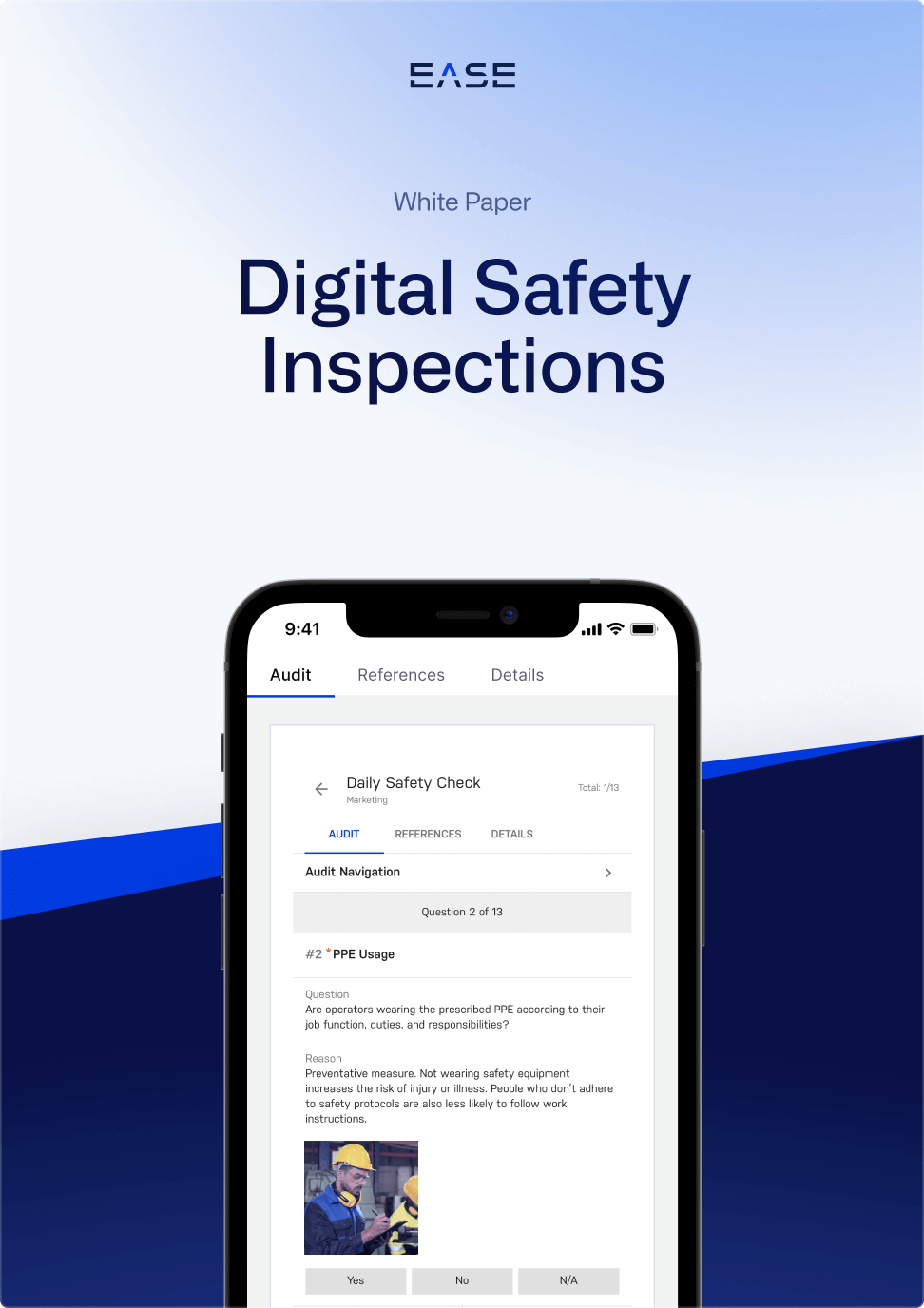How to Reduce Manufacturing Costs with Connected Worker Software

According to the American Society for Quality (ASQ), cost of poor quality ranges anywhere from 10% of revenue in a thriving organization up to 40% for low-end performers.
In practical terms, that means anywhere from $100 million to a staggering $400 million for a hypothetical $1 billion manufacturer.
How can manufacturers prevent these avoidable losses to get to the next level of performance and profitability?
Connected worker software is emerging as a key answer to this question. Below we explore how to reduce manufacturing costs with connected worker software, focusing on key capabilities and examples related to:
- Improving consistency of plant floor checks
- Connecting Workers to Real-Time Assistance
- Centralizing Frontline Knowledge
- Leveraging IoT Sensor Data on the Plant Floor
- Accelerating Issue Management
Download your free eBook on Cost of Quality: The Hidden Truth About Your Most Important Operational Metric
Improving Consistency of Plant Floor Checks
Conducting frequent plant floor checks is vital to identifying how to reduce manufacturing costs. Plant floor checks such as layered process audits ensure that processes meet defined standards by identifying process non-compliances that lead to defects. However, conducting checks can be labor-intensive when relying on manual methods such as Excel and paper checklists, leading to low audit completion rates.
Connected worker software changes the equation by allowing people to quickly access checklists on mobile devices, upload detailed findings and identify process errors in real-time. This reduces manufacturing costs through:
- Reduced downtime: Frequent verification of process parameters such as material inputs and machine settings is crucial to reducing downtime, estimated to cost over $1 million per hour in the automotive industry.
- Fewer defects and complaints: Checking process inputs regularly catches errors before defective products are made and shipped to customers, reducing costs associated with addressing complaints. This is important considering the steep fees OEMs charge to suppliers for line stoppages, which total as much as $30,000 per hour according to Supply Chain Dive.
- Reduced scrap: Scrap and rework costs manufacturers as much as 2.2% of sales, according to the American Productivity and Quality Center. If plant floor checks can reduce scrap by even a modest 10%, that equates to millions of dollars in savings for many manufacturers.
One real-life example comes from Valeo, a manufacturer of automotive wipers. After receiving a customer complaint over faulty pivot tubes, the manufacturer added a step to the manufacturing process to prevent the defect from occurring.
With just a few clicks, the plant then created was able to create a new layered process audit question that included a visual standard so that the team could verify the new process was followed. Digital layered process audits made it simple to check the process daily, with the new question appearing automatically on mobile checklists. As a result, the team eliminated the pivot tube issue and achieving achieved a 50% reduction in quality costs.
Connecting Workers to Real-Time Assistance
Front-line workers have traditionally been isolated on the plant floor, such that when issues arise, they must rely on their own capacity or expertise to solve them. Connected worker software allows for real-time, bi-directional communication and collaboration among plant floor workers and other departments, improving production visibility and reducing costs in several ways.
Let’s say, for example, an operator on an assembly line runs out of a specific type of bolt. With connected worker software, the individual can send an instant message to the materials department to ensure timely resupply of the required bolts. In turn, this reduces the risk of defects and downtime.
Similarly, connected worker software can connect front-line workers with engineers and experts to troubleshoot issues live, minimizing downtime and costly onsite specialist visits. When an operator encounters a machine issue, they can initiate a video chat with a remote engineering expert via a tablet or wearable device like smart glasses linked to the connected worker platform.
Centralizing Frontline Knowledge
Equipping employees with all the information they need on the plant floor is another way connected worker software helps reduce errors and manufacturing costs.
Examples of what connected worker software provides in this context include:
- Centralized information: Connected worker software digitally organizes mission-critical process information in one place, including standard operating procedures (SOPs), autonomous maintenance instructions, safety guidelines and more. This streamlines the production process while preventing costly errors.
- Customized procedure checklists: Manufacturers can use connected worker software to tailor knowledge delivery to the operator’s experience level. For instance, new workers might need a detailed 10-step procedure checklist, whereas experienced operators might only need the three most critical steps or to perform a final quality check. Guided procedure checklists can also highlight known mistakes to avoid to prevent defects.
- Online troubleshooting guides: Should a machine issue occur on the plant floor, connected worker software can allow workers to immediately pull up detailed instructions to resolve issues. This prevents downtime since operators don’t need to search for a physical manual or delay production until a specialist is available to assist.
- Workforce development and skills training: Skills matrix tracking allows companies to identify skill gaps and additional training opportunities. Operators gain new skills, reducing labor costs associated with additional external hires.
- Reminders and alerts: A manufacturer can also use connected worker software to send quality alerts directly to operators’ mobile devices. Focusing only on the most important communications, management can ensure workers are aware of production changes and critical quality issues to watch. The result is fewer process errors, defects and downtime.
Leveraging IoT Sensor Data on the Plant Floor
Demand for Internet of Things (IoT) is growing in manufacturing, and is forecast to grow over 20% annually in coming years according to Allied Market Research. Using IoT’s vast troves of data to reduce manufacturing costs, however, requires putting it in the hands of those who need it most: front-line workers. Connected worker software makes this essential link, helping improve efficiency and productivity through better anomaly detection and equipment optimization.
For example, imagine an automotive manufacturer using IoT sensors on axle carriers in an assembly process, with built-in analytics for automatically testing axles at the end of the line.
Every time an axle fails testing, operators must hoist the axle off the carrier onto a manual cart and move it to an alternate test stand. This process creates added work and ergonomic risks to workers, while also slowing down production. After testing, they discover that most of the axles aren’t actually defective, despite the high rate of failures identified by carrier analytics.
Isolating the data by carrier, they discover that a single carrier is responsible for 95% of test failures—all because of a single broken sensor. Connected worker software connects the IoT data with plant floor operations by:
- Alerting the operator that the carrier has failed the last three of five tests
- Guiding the operator to tag the carrier for maintenance and move it offline
- Notifying maintenance about the specific carrier and sensor that failed testing so it can be promptly repaired
The result is faster correction of equipment issues, fewer production slowdowns and higher productivity overall.
Accelerating Issue Management
The speed at which organizations resolve problems is directly related to their ability to reduce manufacturing costs. When corrective action times are slow, problems are more likely to grow, affecting more processes, products, and ultimately, customers.
Using connected worker software to create a closed-loop issue management process accelerates problem-solving and reduces manufacturing costs with the ability to:
- Capture more and better data: Team members can log audit findings in real time, including with photos from the shop floor to clarify problems and streamline root cause analysis. People can also log ad-hoc observations, so more risks are caught before they become bigger problems.
- Assign action items: Connected worker software allows you to assign mitigation steps and other action items to those responsible, as well as set specific due dates to keep the process on track.
- Ensure accountability: When people miss deadlines or action items aren’t completed, the software can automatically escalate the issue to a supervisor.
- Document solutions: Mitigations and corrective actions can be logged in the software and integrated with relevant enterprise systems such as the quality management system (QMS) or environmental, health and safety (EHS) management system for a complete record of the event. Companies can report to customers how they resolved the problem, increasing customer satisfaction. This information can also be used to accelerate future root cause analysis for similar issues, or incorporated into failure mode and effects analysis (FMEA) to mitigate risk upstream.
- Verify corrections: Once a solution is in place, connected worker software makes it easy to add in regular checks to ensure gains are maintained. For instance, if the correction involved adding a new testing step, a new question can be easily added to plant floor checklists to verify that operators perform it.
Combining digital plant floor audits with automated issue management helped one automotive manufacturer reduce overdue corrective actions by 94%. This, in turn, corresponded with a 73% reduction in internal defects and lower scrap costs.
For manufacturers concerned with how to reduce manufacturing costs, addressing the cost of poor quality is a fundamental challenge. In the past, operators were isolated from the team members, data and key information they needed to do their best work, leading to increased cost. Today, connected worker software is helping bridge that gap, so companies can solve problems faster and achieve higher first-time quality.
